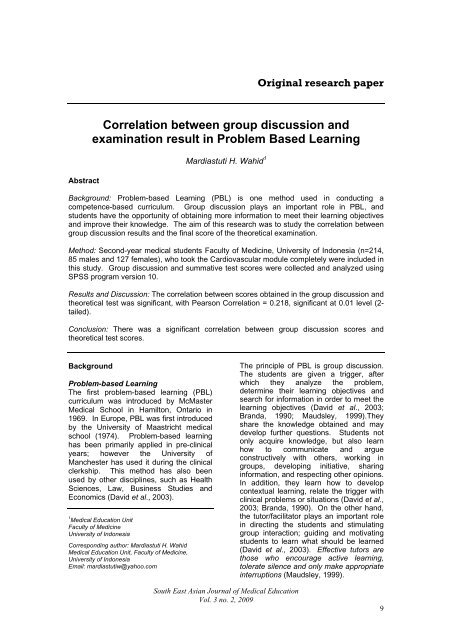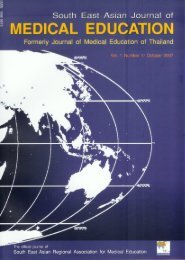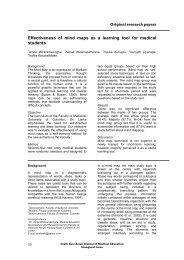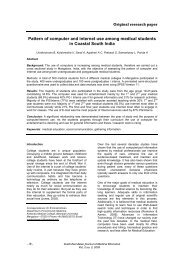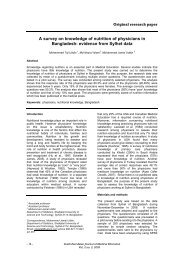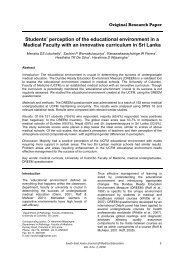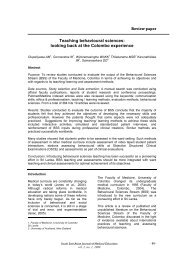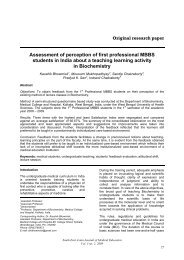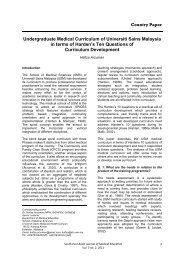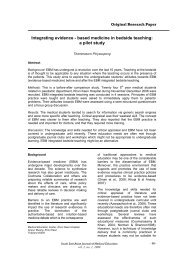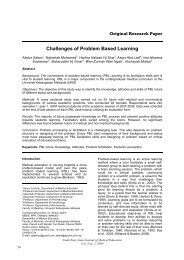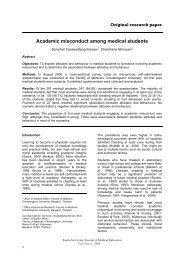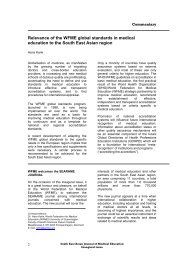Correlation between group discussion and examination result in ...
Correlation between group discussion and examination result in ...
Correlation between group discussion and examination result in ...
Create successful ePaper yourself
Turn your PDF publications into a flip-book with our unique Google optimized e-Paper software.
Orig<strong>in</strong>al research paper<br />
Abstract<br />
<strong>Correlation</strong> <strong>between</strong> <strong>group</strong> <strong>discussion</strong> <strong>and</strong><br />
<strong>exam<strong>in</strong>ation</strong> <strong>result</strong> <strong>in</strong> Problem Based Learn<strong>in</strong>g<br />
Mardiastuti H. Wahid 1<br />
Background: Problem-based Learn<strong>in</strong>g (PBL) is one method used <strong>in</strong> conduct<strong>in</strong>g a<br />
competence-based curriculum. Group <strong>discussion</strong> plays an important role <strong>in</strong> PBL, <strong>and</strong><br />
students have the opportunity of obta<strong>in</strong><strong>in</strong>g more <strong>in</strong>formation to meet their learn<strong>in</strong>g objectives<br />
<strong>and</strong> improve their knowledge. The aim of this research was to study the correlation <strong>between</strong><br />
<strong>group</strong> <strong>discussion</strong> <strong>result</strong>s <strong>and</strong> the f<strong>in</strong>al score of the theoretical <strong>exam<strong>in</strong>ation</strong>.<br />
Method: Second-year medical students Faculty of Medic<strong>in</strong>e, University of Indonesia (n=214,<br />
85 males <strong>and</strong> 127 females), who took the Cardiovascular module completely were <strong>in</strong>cluded <strong>in</strong><br />
this study. Group <strong>discussion</strong> <strong>and</strong> summative test scores were collected <strong>and</strong> analyzed us<strong>in</strong>g<br />
SPSS program version 10.<br />
Results <strong>and</strong> Discussion: The correlation <strong>between</strong> scores obta<strong>in</strong>ed <strong>in</strong> the <strong>group</strong> <strong>discussion</strong> <strong>and</strong><br />
theoretical test was significant, with Pearson <strong>Correlation</strong> = 0.218, significant at 0.01 level (2-<br />
tailed).<br />
Conclusion: There was a significant correlation <strong>between</strong> <strong>group</strong> <strong>discussion</strong> scores <strong>and</strong><br />
theoretical test scores.<br />
Background<br />
Problem-based Learn<strong>in</strong>g<br />
The first problem-based learn<strong>in</strong>g (PBL)<br />
curriculum was <strong>in</strong>troduced by McMaster<br />
Medical School <strong>in</strong> Hamilton, Ontario <strong>in</strong><br />
1969. In Europe, PBL was first <strong>in</strong>troduced<br />
by the University of Maastricht medical<br />
school (1974). Problem-based learn<strong>in</strong>g<br />
has been primarily applied <strong>in</strong> pre-cl<strong>in</strong>ical<br />
years; however the University of<br />
Manchester has used it dur<strong>in</strong>g the cl<strong>in</strong>ical<br />
clerkship. This method has also been<br />
used by other discipl<strong>in</strong>es, such as Health<br />
Sciences, Law, Bus<strong>in</strong>ess Studies <strong>and</strong><br />
Economics (David et al., 2003).<br />
1<br />
Medical Education Unit<br />
Faculty of Medic<strong>in</strong>e<br />
University of Indonesia<br />
Correspond<strong>in</strong>g author: Mardiastuti H. Wahid<br />
Medical Education Unit, Faculty of Medic<strong>in</strong>e,<br />
University of Indonesia<br />
Email: mardiastutiw@yahoo.com<br />
The pr<strong>in</strong>ciple of PBL is <strong>group</strong> <strong>discussion</strong>.<br />
The students are given a trigger, after<br />
which they analyze the problem,<br />
determ<strong>in</strong>e their learn<strong>in</strong>g objectives <strong>and</strong><br />
search for <strong>in</strong>formation <strong>in</strong> order to meet the<br />
learn<strong>in</strong>g objectives (David et al., 2003;<br />
Br<strong>and</strong>a, 1990; Maudsley, 1999).They<br />
share the knowledge obta<strong>in</strong>ed <strong>and</strong> may<br />
develop further questions. Students not<br />
only acquire knowledge, but also learn<br />
how to communicate <strong>and</strong> argue<br />
constructively with others, work<strong>in</strong>g <strong>in</strong><br />
<strong>group</strong>s, develop<strong>in</strong>g <strong>in</strong>itiative, shar<strong>in</strong>g<br />
<strong>in</strong>formation, <strong>and</strong> respect<strong>in</strong>g other op<strong>in</strong>ions.<br />
In addition, they learn how to develop<br />
contextual learn<strong>in</strong>g, relate the trigger with<br />
cl<strong>in</strong>ical problems or situations (David et al.,<br />
2003; Br<strong>and</strong>a, 1990). On the other h<strong>and</strong>,<br />
the tutor/facilitator plays an important role<br />
<strong>in</strong> direct<strong>in</strong>g the students <strong>and</strong> stimulat<strong>in</strong>g<br />
<strong>group</strong> <strong>in</strong>teraction; guid<strong>in</strong>g <strong>and</strong> motivat<strong>in</strong>g<br />
students to learn what should be learned<br />
(David et al., 2003). Effective tutors are<br />
those who encourage active learn<strong>in</strong>g,<br />
tolerate silence <strong>and</strong> only make appropriate<br />
<strong>in</strong>terruptions (Maudsley, 1999).<br />
South East Asian Journal of Medical Education<br />
Vol. 3 no. 2, 2009<br />
9
In PBL, self-directed learn<strong>in</strong>g (SDL) is an<br />
important part; PBL cannot be effective<br />
without SDL. Self-directed learn<strong>in</strong>g is a<br />
major requirement for ma<strong>in</strong>ta<strong>in</strong><strong>in</strong>g<br />
st<strong>and</strong>ards of competence <strong>in</strong> professional<br />
practice (Br<strong>and</strong>a, 1990).<br />
Assessment <strong>in</strong> PBL<br />
Student assessment <strong>in</strong> PBL must be<br />
aligned with the learn<strong>in</strong>g objectives (David<br />
et al., 2003; Am<strong>in</strong> & Hoon, 2003; <strong>and</strong><br />
Sav<strong>in</strong>-Baden & Major, 2004). Accord<strong>in</strong>g to<br />
Am<strong>in</strong> <strong>and</strong> Hoon (2003), student<br />
assessment <strong>in</strong> PBL should consider the<br />
follow<strong>in</strong>g matters:<br />
1. Not merely test the factual knowledge<br />
2. Should provide feedback not only to<br />
students, but also to teachers<br />
3. Should assess process skills: problem<br />
identification, problem-solv<strong>in</strong>g, <strong>and</strong><br />
application of knowledge <strong>in</strong> practice<br />
Therefore knowledge, behaviour <strong>and</strong> skills<br />
should be assessed. Student assessment<br />
can be done <strong>in</strong>formally or formally <strong>in</strong> order<br />
to get more opportunities for achievement<br />
(David et al., 2003; Am<strong>in</strong> & Hoon, 2003;<br />
Sav<strong>in</strong>-Baden & Major, 2004). Content<br />
knowledge can further be assessed by<br />
us<strong>in</strong>g MCQ, MEQ, essays etc. (Am<strong>in</strong> &<br />
Hoon, 2003).<br />
New Curriculum <strong>in</strong> the Faculty of<br />
Medic<strong>in</strong>e, University of Indonesia<br />
Before 1995, the Faculty of Medic<strong>in</strong>e,<br />
University of Indonesia (FMUI) applied<br />
traditional teach<strong>in</strong>g methods ma<strong>in</strong>ly<br />
consist<strong>in</strong>g of lectures <strong>and</strong> practical<br />
laboratory activities. In 1995, FMUI<br />
developed a curriculum us<strong>in</strong>g the PBL<br />
approach. Unfortunately it was not<br />
implemented well due to a lack of staff<br />
underst<strong>and</strong><strong>in</strong>g <strong>and</strong> support. In addition,<br />
the facilities were also not ideal.<br />
In the year 2005, the M<strong>in</strong>istry of Education<br />
declared that all medical schools should<br />
conform to a new competency based<br />
curriculum. The curriculum comprised of<br />
self directed learn<strong>in</strong>g <strong>and</strong> active learn<strong>in</strong>g.<br />
To implement the curricular reforms, FMUI<br />
developed the Faculty Curriculum 2005.<br />
This new curriculum was prepared with<strong>in</strong> 6<br />
months by the Medical Education Unit with<br />
support from other academic staff<br />
members who were concerned about<br />
medical education. Support<strong>in</strong>g facilities<br />
were completed <strong>in</strong>clud<strong>in</strong>g rooms for<br />
<strong>discussion</strong>, audio visual aids, books, 24-<br />
hour library facilities, computer lab, skills<br />
lab <strong>and</strong> other laboratory facilities. The<br />
five-year curriculum uses PBL as one<br />
method of choice, ma<strong>in</strong>ly <strong>in</strong> medical<br />
sciences. Dur<strong>in</strong>g the last year of study,<br />
the 6 th year, students will have their<br />
<strong>in</strong>ternship programme which is conducted<br />
by the collegiums of professional <strong>group</strong>s.<br />
Other methods used <strong>in</strong> this curriculum are<br />
lectures, basic cl<strong>in</strong>ical skill practices,<br />
laboratory activities, plenary <strong>discussion</strong>s<br />
<strong>and</strong> other modules on research <strong>and</strong><br />
empathy. In addition, <strong>in</strong> the cardiovascular<br />
module the students visit the Cardiac<br />
Center Hospital <strong>in</strong> order to improve their<br />
knowledge <strong>and</strong> underst<strong>and</strong><strong>in</strong>g of the<br />
cardiovascular system.<br />
To evaluate the cardiovascular module, a<br />
study was conducted to determ<strong>in</strong>e the<br />
correlation <strong>between</strong> <strong>group</strong> <strong>discussion</strong><br />
<strong>result</strong>s <strong>and</strong> the f<strong>in</strong>al score at the<br />
theoretical test.<br />
Method<br />
Second-year medical students, Faculty of<br />
Medic<strong>in</strong>e, University of Indonesia (n=212;<br />
85 males <strong>and</strong> 127 females) who had taken<br />
the Cardiovascular module completely<br />
were <strong>in</strong>cluded <strong>in</strong> this study. Only 2<br />
students who had not completely attended<br />
the activities were excluded. The module<br />
was conducted dur<strong>in</strong>g 6 weeks <strong>and</strong><br />
consisted of 5 triggers (problems), 23<br />
hours of lectures from several discipl<strong>in</strong>es,<br />
25 hours of <strong>group</strong> <strong>discussion</strong>, 46 hours of<br />
self study, 16 hours of tra<strong>in</strong><strong>in</strong>g <strong>in</strong> basic<br />
cl<strong>in</strong>ical skills, 24 hours of laboratory work<br />
<strong>and</strong> 20 hours of plenary <strong>discussion</strong>.<br />
The <strong>group</strong> <strong>discussion</strong><br />
Group <strong>discussion</strong>s were held twice a week<br />
for periods of 2-3 hours, supervised by a<br />
tra<strong>in</strong>ed facilitator. The students were<br />
divided <strong>in</strong>to 21 <strong>group</strong>s, each evaluated by<br />
one facilitator for five weeks; 21 evaluators<br />
were <strong>in</strong>volved <strong>in</strong> this study. Each <strong>group</strong><br />
consisted of 10-12 students, selected<br />
consider<strong>in</strong>g their GPA, so that students<br />
were evenly distributed. The facilitators<br />
completed a student evaluation form<br />
consist<strong>in</strong>g of items on shar<strong>in</strong>g, knowledge,<br />
argumentation, activities, dom<strong>in</strong>ancy,<br />
discipl<strong>in</strong>es, <strong>and</strong> attitude. Figure 1<br />
demonstrates the student evaluation form.<br />
10<br />
South East Asian Journal of Medical Education<br />
Vol. 3 no. 2, 2009
Figure 1: Students’ evaluation form<br />
Group : (filled by secretariat) Module : (filled by secretariat)<br />
Facilitator Name : ___________ Academic year :______(filled by secretariat)<br />
Trigger : 1 / 2 / 3 / 4 / 5 / 6<br />
No<br />
N A M E<br />
(filled by secretariat)<br />
Involvement<br />
Shar<strong>in</strong>g<br />
Argumentation<br />
Activity<br />
Dom<strong>in</strong>ant<br />
Behaviour<br />
Discipl<strong>in</strong>e/<br />
Attendance<br />
Manner<br />
1 (filled by secretariat)<br />
2<br />
3<br />
4<br />
5<br />
6<br />
7<br />
8<br />
9<br />
10<br />
11<br />
1 2 1 2 1 2 1 2 1 2 1 2<br />
Score<br />
Score<br />
1 3 5 -2 -1 0<br />
Shar<strong>in</strong>g M<strong>in</strong>imum Sometimes Always Dom<strong>in</strong>ant Yes Sometimes No<br />
Argumentation Poor Fair Good<br />
Activity Poor Fair Good<br />
Discipl<strong>in</strong>e/ Late > 15’ Late < 15’ On time<br />
Attendance<br />
Manner Poor Fair Good<br />
Def<strong>in</strong>ition on evaluation term:<br />
Shar<strong>in</strong>g : shar<strong>in</strong>g <strong>in</strong>formation atta<strong>in</strong>ed dur<strong>in</strong>g self activity session <strong>between</strong> <strong>group</strong> member<br />
Argumentation : giv<strong>in</strong>g logical <strong>and</strong> correct knowledge <strong>in</strong> shar<strong>in</strong>g <strong>and</strong> give logical <strong>and</strong> correct<br />
argumentation based on literature<br />
Activity : active <strong>in</strong> <strong>discussion</strong> without facilitator <strong>in</strong>tervention<br />
Dom<strong>in</strong>ant : dom<strong>in</strong>at<strong>in</strong>g the forum <strong>in</strong> a <strong>group</strong> <strong>discussion</strong><br />
Note:<br />
__________________________________________________________________________<br />
__________________________________________________________________________<br />
__________________________________________________________________________<br />
Student note books were also evaluated,<br />
but not <strong>in</strong>cluded <strong>in</strong> the <strong>group</strong> <strong>discussion</strong><br />
score. A day after the second <strong>discussion</strong><br />
session, selected <strong>group</strong>s presented their<br />
<strong>result</strong>s dur<strong>in</strong>g a plenary presentation,<br />
attended by all students <strong>and</strong> resource<br />
persons from several discipl<strong>in</strong>es.<br />
In order to obta<strong>in</strong> feedback on student<br />
performance, formative tests were held <strong>in</strong><br />
the 3 rd <strong>and</strong> 5 th week. The students faced<br />
South East Asian Journal of Medical Education<br />
Vol. 3 no. 2, 2009<br />
summative <strong>exam<strong>in</strong>ation</strong>s twice, dur<strong>in</strong>g the<br />
4 th <strong>and</strong> 6 th weeks. Thereafter, students<br />
who failed the course were required to<br />
take a remedial test <strong>in</strong> the 7 th week. The<br />
exam <strong>in</strong>cluded topics <strong>in</strong> the <strong>group</strong><br />
<strong>discussion</strong>s, lectures <strong>and</strong> plenary session.<br />
Group <strong>discussion</strong> <strong>and</strong> summative test<br />
scores were collected <strong>and</strong> analyzed us<strong>in</strong>g<br />
the SPSS programme version 10 with 95%<br />
Confidence Interval of the Difference.<br />
11
Questionnaires distributed to the students<br />
collected <strong>in</strong>formation on the learn<strong>in</strong>g<br />
facilities, the Students’ Guide, lecturers,<br />
cases, facilitator performance <strong>and</strong><br />
assessment. How well the facilitator<br />
helped the students dur<strong>in</strong>g <strong>group</strong><br />
<strong>discussion</strong>s was graded as strongly agree,<br />
agree, not agree, <strong>and</strong> strongly not agree.<br />
The alignment of the tests with the<br />
learn<strong>in</strong>g objectives was also graded as<br />
mentioned above. Assessments were<br />
graded as very difficult, difficult, easy, <strong>and</strong><br />
very easy.<br />
Results <strong>and</strong> Discussion<br />
<strong>Correlation</strong> <strong>between</strong> scores obta<strong>in</strong>ed<br />
dur<strong>in</strong>g the <strong>group</strong> <strong>discussion</strong> <strong>and</strong> the<br />
theoretical test was significant, with<br />
Pearson <strong>Correlation</strong> Sig. (2-tailed) =<br />
0.218. The correlation was significant at<br />
the 0.01 level (2-tailed). In fact, the mean<br />
of theoretical score (66.26) was lower than<br />
the mean of <strong>group</strong> <strong>discussion</strong> score<br />
(86.55). Niem<strong>in</strong>en et al. (2006) found that<br />
<strong>group</strong> function<strong>in</strong>g <strong>and</strong> case quality<br />
correlated with students’ course grades.<br />
Of the 212 questionnaires distributed, only<br />
187 completed questionnaires were<br />
h<strong>and</strong>ed over. Learn<strong>in</strong>g facilities such as<br />
<strong>discussion</strong> rooms, practical lab, reference<br />
facilities etc. were found to be satisfactory.<br />
Most of the students had understood the<br />
Students’ Guide (72.9%) <strong>and</strong> the<br />
objectives of the module (79.8%). They<br />
also agreed that almost all of the lecturers<br />
expla<strong>in</strong> the learn<strong>in</strong>g material clearly. The<br />
cases were reported to have helped<br />
students <strong>in</strong> underst<strong>and</strong><strong>in</strong>g the learn<strong>in</strong>g<br />
objectives.<br />
Twenty eight students (14.97%) strongly<br />
agreed <strong>and</strong> one hundred <strong>and</strong> the thirty<br />
four students (71.66%) agreed that the<br />
facilitator helped <strong>and</strong> directed them dur<strong>in</strong>g<br />
<strong>group</strong> <strong>discussion</strong> (figure 2). Only 13.3%<br />
students were unsatisfied with their<br />
facilitator performance. As the facilitator<br />
performance was high, it may also have<br />
supported students <strong>in</strong> obta<strong>in</strong><strong>in</strong>g high<br />
scores <strong>in</strong> <strong>group</strong> <strong>discussion</strong>. This study is<br />
similar to one by Dolmans et al. (1999)<br />
that showed the average tutorial <strong>group</strong><br />
productivity score was higher if the tutor<br />
performance was higher. Group<br />
productivity <strong>and</strong> tutor’s performance have<br />
an impact on the effectiveness of PBL<br />
modules (Dolmans et al., 1999; Dolmans<br />
& Wolfhagen, 2005).<br />
Figure 2 : The role of facilitator <strong>in</strong> help<strong>in</strong>g <strong>and</strong> direct<strong>in</strong>g students<br />
200<br />
150<br />
134<br />
strongly agree<br />
100<br />
agree<br />
50<br />
28<br />
22<br />
3<br />
not agree<br />
strongly not agree<br />
0<br />
facilitator support<br />
As demonstrated <strong>in</strong> figure 3 the 1 st<br />
summative test was rated as very difficult<br />
by 68.6% students <strong>and</strong> as difficult by<br />
30.3%. They stated that the test materials<br />
were not aligned well with the learn<strong>in</strong>g<br />
objectives. Of the students, 61.2% stated<br />
that the 2 nd summative was very difficult<br />
<strong>and</strong> 23.9% stated that it was difficult.<br />
However, the 2 nd summative material test<br />
was reported to be appropriate with the<br />
learn<strong>in</strong>g objectives. This can be<br />
demonstrated by a low mean value from<br />
score obta<strong>in</strong>ed <strong>in</strong> the summative tests<br />
(66.26).<br />
12<br />
South East Asian Journal of Medical Education<br />
Vol. 3 no. 2, 2009
Figure 3: Students’ perception about the difficulty level of the exam<br />
Figure 4: Student perception on the alignment of exam material with the learn<strong>in</strong>g<br />
objectives<br />
200<br />
150<br />
100<br />
50<br />
0<br />
79<br />
45 60<br />
2<br />
1st summative<br />
131<br />
33<br />
2<br />
10<br />
2nd summative<br />
strongly agree agree not agree strongly not agree<br />
Therefore, there are two possibilities that<br />
support the low correlation <strong>between</strong> the<br />
summative test <strong>and</strong> <strong>group</strong> <strong>discussion</strong><br />
score. First, that the <strong>exam<strong>in</strong>ation</strong> was too<br />
difficult for the students <strong>and</strong> less aligned<br />
with the learn<strong>in</strong>g objectives. Second, even<br />
though the facilitator performance was<br />
high, they may have been too generous <strong>in</strong><br />
mark<strong>in</strong>g the students dur<strong>in</strong>g the <strong>group</strong><br />
<strong>discussion</strong> or may have a little knowledge<br />
<strong>in</strong> giv<strong>in</strong>g appropriate scores. Therefore,<br />
student evaluation should be changed,<br />
after careful review <strong>and</strong> exclusion of test<br />
materiel that is too difficult. Academic staff<br />
should be tra<strong>in</strong>ed, especially <strong>in</strong> student<br />
South East Asian Journal of Medical Education<br />
Vol. 3 no. 2, 2009<br />
assessment <strong>in</strong> order to sufficient<br />
knowledge about construction of good<br />
questions, how to mark the students etc.<br />
In addition, the evaluation form can be<br />
revised to <strong>in</strong>clude the score range, so that<br />
the total score would be more reliable. To<br />
decrease the bias one of a s<strong>in</strong>gle facilitator<br />
mark<strong>in</strong>g <strong>group</strong> <strong>discussion</strong>s, the facilitators<br />
can be rotated weekly so that each <strong>group</strong><br />
is scored by more than one.<br />
As a f<strong>in</strong>al <strong>result</strong>, only 3 students failed <strong>in</strong><br />
the module. These students were found to<br />
have had problems <strong>in</strong> several other<br />
modules as well.<br />
13
Conclusion<br />
There was a significant correlation<br />
<strong>between</strong> the <strong>group</strong> <strong>discussion</strong> score <strong>and</strong><br />
theoretical test score, even though the<br />
correlation was low. Further studies should<br />
be conducted to study the impact of<br />
Problem Based Learn<strong>in</strong>g on students’<br />
learn<strong>in</strong>g abilities.<br />
References<br />
Am<strong>in</strong>, Z., & Hoon Eng, K. (2003) Student<br />
assessment <strong>in</strong> problem based learn<strong>in</strong>g. In:<br />
Basics <strong>in</strong> medical education, World Scientific.<br />
New Jersey, London, S<strong>in</strong>gapore, Shanghai,<br />
Hong Kong, Taipei, Bangalore.<br />
Br<strong>and</strong>a, L.A. (1990) Implement<strong>in</strong>g problem<br />
based learn<strong>in</strong>g, Journal of Dental Education,<br />
54(9), pp. 548-549.<br />
David, T., Patel, L., Burdett, K. & Rangachari,<br />
P. (2003) Self-assessment, peer-assessment,<br />
<strong>and</strong> tutor assessment, In: Problem-based<br />
learn<strong>in</strong>g <strong>in</strong> medic<strong>in</strong>e: A practical guide for<br />
students <strong>and</strong> teachers, Worcester: Royal<br />
Society of Medic<strong>in</strong>e Press Ltd.<br />
Dolmans, D.H.J.M., Wolfhagen, I.H.A.P.,<br />
Hoogenboom, R.J.I. & Van der Vleuten, C.P.M.<br />
(1999) Is tutor performance dependent on the<br />
tutorial <strong>group</strong>’s productivity: Toward further<br />
resolv<strong>in</strong>g of <strong>in</strong>consistencies <strong>in</strong> tutor<br />
performance, Teach<strong>in</strong>g <strong>and</strong> Learn<strong>in</strong>g <strong>in</strong><br />
Medic<strong>in</strong>e, 11(4), pp. 186-191.<br />
Dolmans, D.H.J.M. & Wolfhagen, I.H.A.P.<br />
(2005) Complex <strong>in</strong>teractions <strong>between</strong> tutor<br />
performance, tutorial <strong>group</strong> productivity <strong>and</strong> the<br />
effectiveness of problem based learn<strong>in</strong>g units<br />
as perceived by students, Advances <strong>in</strong> Health<br />
Sciences Education, 10(3), pp. 253-261.<br />
Maudsley, G. (1999) Education <strong>and</strong> debate.<br />
Roles <strong>and</strong> responsibilities of the problem based<br />
learn<strong>in</strong>g tutor <strong>in</strong> the undergraduate medical<br />
curriculum, British Medical Journal, 318, pp.<br />
657-661.<br />
Niem<strong>in</strong>en, J., Sauri, P. & Kirsti, L. (2006) On<br />
the relationship <strong>between</strong> <strong>group</strong> function<strong>in</strong>g <strong>and</strong><br />
study success <strong>in</strong> problem-based learn<strong>in</strong>g,<br />
Medical Education, 40, pp. 64-71.<br />
Sav<strong>in</strong>-Baden, M. & Major C.H. (2004)<br />
Assess<strong>in</strong>g problem based learn<strong>in</strong>g. In: Egg<strong>in</strong>s<br />
H. (ed), Foundations of problem based<br />
learn<strong>in</strong>g, The Society for Research Into Higher<br />
Education <strong>and</strong> Open University Press.<br />
14<br />
South East Asian Journal of Medical Education<br />
Vol. 3 no. 2, 2009


